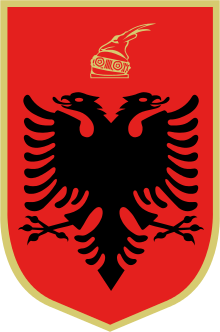Sanjak of Dibra
| Sanjak of Dibra Debre Sancağı Sanxhaku i Dibrës Дебарски санџак | |||||
| sanjak of the Ottoman Empire | |||||
| |||||
|
Coat of arms | |||||
.png) | |||||
| Capital | Debar | ||||
| History | |||||
| • | Established | 1395 | |||
| • | Treaty of London (1913) | 30 May 1913 1913 | |||
| Today part of | Albania and Republic of Macedonia | ||||
Sanjak of Dibra, or Sanjak of Debar, (Turkish: Debre Sancağı, Albanian: Sanxhaku i Dibrës, Macedonian: Дебарски санџак) was one of the sanjaks of the Ottoman Empire which county town was Debar in Macedonia.[1] The western part of its territory today belongs to Albania (Lower Dibër and Mat) and the east to the Republic of Macedonia (Reka, Debar).
Territory and administration
Besides Debar the territory of this sanjak included part of territory of northern Albania, Krujë and areas between rivers Mat and Black Drin.[2] In 1440 Skanderbeg was appointed as sanjakbey of Sanjak of Debar.[3][4] Since mid-19th century the Sanjak of Dibra had two kazas: Debar and Reka.[5] Before its disestablishment in 1912 it had four kazas: Debar, Reka, Mat and Lower Debar.[6]
Scutari, Prizren, Kosovo and Monastir vilayets
In 1867, the Sanjak of Debar merged with the Sanjak of Prizren and Sanjak of Scutari and became the Scutari Vilayet. In 1871 Sanjak of Debar was joined with the Sanjak of Prizren, Sanjak of Skopje and Sanjak of Niš into one vilayet, Prizren Vilayet, which became part of the Kosovo Vilayet when it was established in 1877.[7][8]
The Sanjak of Debar was separated from the Kosovo Vilayet and attached to the Monastir Vilayet after the Congress of Berlin in 1878.[9] A half of the supplies of the sanjak of Dibra in period before its disestablishment came from Skopje and a quarter from Bitola.[10]
Disestablishment
During the First Balkan War in 1912 and beginning of 1913 Sanjak of Debar was occupied by the Kingdom of Serbia. In 1914 the territory of Sanjak of Scutari became a part of Principality of Albania, established on the basis of peace contract signed during London Conference in 1913.[11] On the basis of the Treaty of London signed during the London Conference in 1913, its territory was divided between Serbia and newly established Albania.
Demographics
1897
According to Russian consul in the Manastir Vilayet, A. Rostkovski, finishing the statistical article in 1897, the total population was 82,644. Albanians were 52,144. In Upper Dibra and Reka there were 3,548 Albanian Christians; in Reka there were 3,518 Albanian Muslims, and 2,342 Albanian Christians. In Upper Dibra there were 12,355 Slavic Exarchists and 3,638 Slavic Patriarchists. In Reka there were 11,850 Slavic Exarchists and 172 Slavic Patriarchists. In Lower Dibra and Mat there were no Slavs. No Turks-Ottomans were recorded.[12]
Governors
- Skanderbeg (1440–November 1443)
- Moisi Golemi (1455–?)
- Abdullah Pasha (fl. 1897)[13]
References
- ↑ Vickers, Miranda; Pettifer, James (2007). The Albanian question: reshaping the Balkans. I.B.Tauris. p. 7. ISBN 978-1-86064-974-5.
Dibra and its surrounding became separate sanjak
- ↑ Zhelyazkova, Antonina. "Albanian identities" (PDF). Retrieved 3 April 2011.
portion of the north Albanian lands was included in the sancak of Debar, namely Kruja, Debar and the areas lying between the rivers of Mat and Black Drin
- ↑ Zhelyazkova, Antonina. "Albanian identities". Archived from the original on 3 April 2011. Retrieved 3 April 2011.
In 1440, he was promoted to sancakbey of Debar
- ↑ Hösch, Peter (1972). The Balkans: a short history from Greek times to the present day, Volume 1972, Part 2. Crane, Russak. p. 96. ISBN 978-0-8448-0072-1. Retrieved 4 April 2011.
- ↑ Aleksandar Matkovski (1959). Ǧurčin Kokaleski. p. 73. Retrieved 22 July 2013.
..До првата половина на XIX век „Деборија" админи- стративно припаѓала во Дебарскиот пашалак, покасно кон Дебарскиот санџак (дебре - санџаги) кој се делел на Дебарска каза со седиште во дебар и на Реканска каза со
- ↑ Ivan Ivanić (1910). Maćedonija i maćedondži. Štampa Savića i Komp. p. 30. Retrieved 22 July 2013.
Дебарски санџак има четири казе: Дебарску, матску, доњодебарску и речку (Река)
- ↑ Akşin Somel, Selçuk (2001). The modernization of public education in the Ottoman Empire, 1839–1908. Netherlands: Brill. p. 234. ISBN 90-04-11903-5. Retrieved 2 August 2011.
the vilayet of Prizren was founded in 1871
- ↑ Grandits, Hannes; Nathalie Clayer; Robert Pichler (2010). Conflicting Loyalties in the Balkans The Great Powers, the Ottoman Empire and Nation-building. Gardners Books. p. 309. ISBN 978-1-84885-477-2. Retrieved 5 May 2011.
In 1868 the vilayet of Prizren was created with the sancaks of Prizren, Dibra, Skopje and Niš; it only existed till 1877
- ↑ Apostoloski, Mihailo (1978). Makedonija vo istočnata kriza 1875–1881. Skopje: Makedonska akademija na naukite i umetnostite. p. 187. Retrieved 13 May 2011.
After the Berlin Congress other administrative reforms were carried out. So the Debar Sanjak was separated from Kosovo Vilayet and was added to the Bitola vilayet...
- ↑ Brastvo. Društvo sv. Save. 1940. p. 176. Retrieved 22 July 2013.
Уопште Дебарски санџак се, у последње време до осло- бођења, трговачким артиклима са 50°/» снабдевао из Скопља а са 25°/» из Битоља.
- ↑ Vickers, Miranda (1999). The Albanians: a modern history. I.B.Tauris. pp. 77, 78. ISBN 978-1-86064-541-9.
- ↑ "Jedna statistika iz srednje Maćedonije". Nova Iskra (15–16): 251. 26 July 1899.
- ↑ British and Foreign State Papers. H.M. Stationery Office. 1897.

